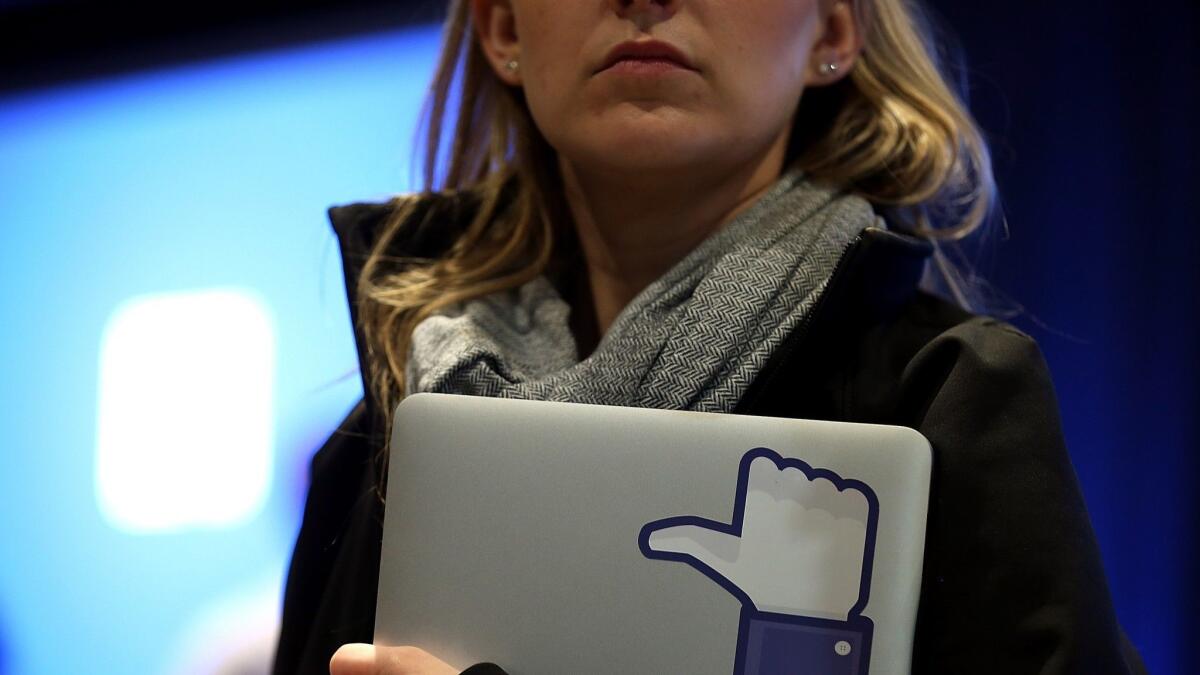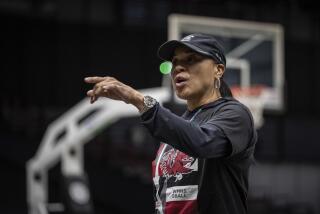Amazon, Bank of America and Facebook are under pressure to reveal their median gender pay gap

- Share via
An investor activist said Wednesday it is targeting 11 additional financial and tech firms — including Facebook, Google parent Alphabet, JPMorgan Chase and Bank of America — urging them in new shareholder proposals to disclose an unfiltered and likely unflattering global gender pay gap statistic that few companies want to reveal.
The filings by Arjuna Capital, which could end up on investors’ proxy ballots this year, follow Citigroup’s surprise move to publish its figure after a proposal from Arjuna. The financial services giant said in January that its unadjusted global median pay for women is 29% less than it is for men, setting a bar that could pressure other companies to follow suit.
It also builds on a requirement now mandated in Britain that requires companies with more than 250 British workers to disclose data on median gender wage gaps in that country. Among the companies targeted, double-digit gaps are common. In addition to the firms listed above, the campaign is also asking Adobe, Amazon, Intel, Bank of America, Wells Fargo, Mastercard and American Express to provide the figure.
These firms have been urged by Arjuna in the past to reveal what’s often called their “pay equity gap,” which compares what women make to men who work in the same jobs — and is often adjusted for things like seniority or geography. Sharing that figure, which companies often report at 99% or even 100% of men’s earnings, was an easier pill for companies to swallow.
The median gender pay gap, meanwhile, shines a harsher spotlight on a what’s known as the “position gap,” revealing how many women, compared to men, are in a company’s top-ranking, highest paying jobs. It can lead to awkward headlines about double-digit pay gaps — even if men and women with similar experience are paid the same in equal jobs.
Having companies report both figures tells a more complete story, Lamb said Wednesday. The median pay gap is “a very clean way of looking to see whether men or women are holding the bulk of higher paying jobs,” she said.
“Investors want a baseline from which to measure progress. They want to know how the money falls in the organization,” she said. If more attention is drawn to the issue, she hopes, “there will be more women in leadership, and more women in higher-paying positions that will ultimately bring better balance, better performance and better decision making.”
The median gender pay gap also accounts for powerful employees in industries like financial services or tech, where highly paid engineers with specialized skills or successful traders may not sit on the typical leadership organizational chart, and could get missed if companies only reported gender “representation,” or the percentage of women in executive management jobs.
Lamb said that only Citi had yet followed through on her request, and that she is in “active dialogues” with other companies. Three of the companies, which she would not disclose, have filed challenges trying to block the proposals at the U.S. Securities and Exchange Commission.
In response to emails from the Washington Post, many of the targeted companies declined to comment, did not respond or pointed to past pay equity or diversity figures. A spokeswoman for American Express said it had received the proposal and will be getting “back to Arjuna directly.” Intel’s director of compensation and benefits, Julie Ann Overcash, said in an emailed statement that “we are ensuring pay equity for all our employees in the same or similar jobs while at the same time working toward increased representation of women and underrepresented minorities at all levels.”
Asking companies to disclose the median pay gap figure is somewhat controversial, however, in an environment where the pay gap is often misunderstood and the difference between pay equity and the pay gap are easily muddled. The median figure has been criticized as a blunt instrument that’s hard to compare between firms and one that could lead to misleading figures.
Brian Levine, a partner at the human resources consulting firm Mercer who works with Citi and other financial services firms, called Arjuna’s effort “positive in the sense that it’s expanding what companies are going to put out, ultimately,” and said it was sparking more dialogue about the issue that could result in more information for shareholders.
But he didn’t think all the companies targeted would report the figure. “I think they’ll put out more than what they’ve put out in the past,” he said. “But that one statistic has a lot of bias.”
He used the hypothetical example of a bank where half the highest paying jobs were held by women and half by men, but a majority of lower-paying positions like tellers were held by women. At the median, there could still be a pay gap, “but it’s not the case that the organization is treating women unfairly.”
Some research indicates that disclosure can prompt the pay gap to shrink. A study in the Harvard Business Review in January, for instance, looked at companies in Denmark that were subject to gender pay gap reporting mandates. It found that disclosing those disparities not only narrowed the gap, but increased the number of women being hired and promoted — while also lowering companies’ overall compensation costs, “largely by slowing down the growth of male wages.”
Lamb said that while the median pay gap may not be perfect, calling for disclosure of the data isn’t meant to create a “shock factor.” “One of the reasons we want the data is not so much as a ‘gotcha — your gap isn’t closed completely,’ but so that we know what it is and we know how it changes over time,” she said. “What people are paid is a reflection of their value to the company, and who the company values.”
Two nonprofit groups focused on women and the pay gap, Equal Rights Advocates and the Closing the Women’s Wealth Gap initiative, said Wednesday they support Arjuna’s proposals.
“The test of whether women are equally valued in the workplace can’t end with whether they’re paid equally for the same work,” said Noreen Farrell, ERA’s executive director. They need to be “equally represented among their highest paid leaders. That’s why the median pay gap is so important.”
More to Read
Inside the business of entertainment
The Wide Shot brings you news, analysis and insights on everything from streaming wars to production — and what it all means for the future.
You may occasionally receive promotional content from the Los Angeles Times.









